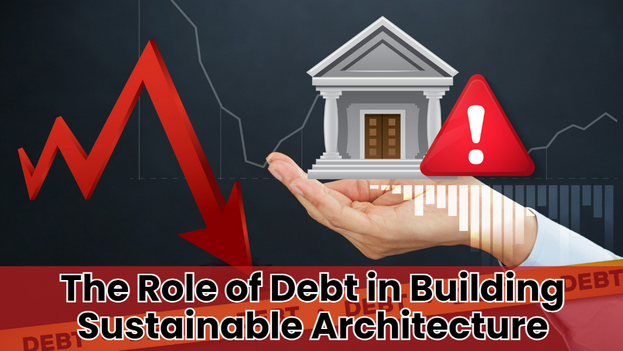Is it possible to put financial responsibility in harmony with the dream of sustainable architecture? Does debt positively contribute to funding the concept of an eco-friendly building, or is it a burden against innovation? How do architects and developers fund their advanced sustainable designs without sacrificing long-term prospects?
These are all the questions that arise when it comes to the role of debt in building sustainable architecture. Debt can indeed be a good source of financing as it helps build well-considered green and sustainable yet financially viable architecture for the future.
Let’s have a closer look at how debt is going to facilitate sustainable architectural growth and what opportunities it will allow for building a better future.
Financing Green Projects Through Loans and Bonds
Loans and green bonds are probably the most concrete ways that funds for sustainable architecture will be sourced. Simply put, these financial instruments enable the developer or architect to borrow to initiate or complete environmentally friendly projects.
For example, green bonds can finance positive environmental impact projects, such as energy-efficient buildings and renewable energy infrastructure projects. Whereby the developers take on debt, which can be through these avenues, to finance large-scale projects that otherwise may not be affordable.
This debt provides loans and initial capital for projects aimed at sustainability, such as incorporating solar panels during construction and harvesting rainwater. In some situations, understanding how to get a debt lawsuit dismissed can be crucial for maintaining financial stability, allowing developers to focus on using energy-efficient materials and other sustainable practices without the distraction of legal disputes.
Debt in this context will enable the realization of projects that prioritize the environment without even waiting for years to gather enough capital.
Spreading Costs Over Time

Ordinarily, sustainable architecture is more expensive upfront compared to traditional construction. Energy-efficient materials, renewable sources of energy, and green technologies will generally be more expensive to implement at a given time, but the savings made over long periods in terms of energy bills and maintenance can offset many of those investments.
In doing so, debt allows developers to spread the front-end cost over a longer period, making the undertaking financially feasible. With loan or financing agreements, the developers can mobilize the funds for sustainable construction immediately and repay the loans over time. This spreads the cost of an enormous upfront payment, thereby enabling more projects to be implemented within financial limits.
Debt as a Motivator of Sustainable Activity
Debt can act as an incentive for developers and architects. If the loans are tied to certain sustainability targets, then developers will be encouraged to design and construct in ways that reduce long-term costs while increasing energy efficiency.
With incentive conditions attached to such loans-for example, lower interest rates on loans awarded for projects that meet certain environmental standards-the benefits of the practice can be realized.
For instance, some financial institutions have come up with green loans or sustainability-linked loans. The interest rate is focused on the environmental performance of the particular project upon which it is tied.
The arrangement is in such a way that if the project attains or surpasses the set sustainability goals, the interest rate can be reduced. It helps the developers opt for green building practices for both the environment and diminishing their financial obligations.
Balancing Short-Term Debt with Long-Term Savings

One of the giant challenges of sustainable architecture is a balance between short-term debt made for financing the project against long-term savings that the building generates. Sustainable buildings retain a lot of energy and water; therefore, their utility bills remain low for some period after their construction. This can be used to pay the debt taken in terms of constructing the building.
Take, for example, energy-efficient HVAC systems, solar panels, and water conservation technologies which will give savings on operational costs when compared to an average building.
The saved money on energy and maintaining the building can then be put towards repayment of loans, thereby creating a positive self-repaying feedback loop where it would eventually pay back the loans. For this reason, such fluctuation from short-term debt to longer-term savings makes sustainable architecture a valid investment.
Public-Private Partnerships in Sustainable Development

Another key role that debt takes is in public-private partnerships: their collaborations have governments joining forces with private entities to sponsor large-scale sustainable projects. This often involves debt financing in many instances. The private sector assumes debt for the execution of the project, while government support comes in terms of subsidies or tax incentives for the venture.
These structures enable the establishment of environmentally friendly infrastructure that is in the best interest of the public and is also financially viable for private firms. Private firm debt is offset by the long-term project benefits such as cost reduction in terms of energy consumption, environmental impact, and improved health outcomes for the public health.
Debt and Innovation in Sustainable Materials
Debt financing also promotes the innovation of sustainable materials and technologies. Generally, research and development are capital-intensive activities. Companies take out debt to finance the development of alternative materials that are more environmentally friendly, more energy efficient, or cost-effective than their current alternatives.
Investment in R&D is what inspires the creation of low-carbon concrete, recycled building materials, and sustainable insulations. Companies commit to the financial risk of innovation by debt financing, as they expect, in the longer run, these new materials will help them cut costs and reduce undesirable environmental impacts in the end. Therefore, debt fuels the process of sustainable architecture through new, green solutions for building.
Challenges of Debt in Sustainable Architecture
| Point | Details |
| Debt as a Major Funding Source | Debt is one of the main sources of financing for sustainable projects. |
| Challenges with Debt Financing | Debt financing is not without challenges, as financial risks may arise if not properly managed. |
| Risk of Failed Long-Term Savings | The most significant risk occurs when projects fail to generate the expected long-term savings, making loan repayment difficult. |
| Impact of Rising Interest Rates | Increased interest rates can further complicate the repayment of loans, putting pressure on developers. |
| Struggling to Repay Loans | Developers may struggle to repay loans if the project’s financial returns don’t align with expectations. |
| Pressure for Short-Term Returns | There may be forces pushing for short-term financial returns, which can conflict with long-term sustainability goals. |
| Cost Cutting and Environmental Compromise | To secure cheap financing, developers might cut costs, potentially compromising the environmental integrity of the project. |
| Balancing Financial and Sustainability Commitments | Developers must carefully balance their financial obligations with their commitment to sustainability. |
| Debt as a Tool for Success | When managed properly, debt can support, rather than hinder, the success of sustainable projects. |
Conclusion
Debt is key to producing sustainable architecture when managed. It ensures much-needed capital for large green projects, in which upfront costs are distributed along a timeline, and facilitates sustainable practices through monetary benefits.
Prudent use of debt goes hand in hand with long-term savings, innovation in material sustainability, and public-private partnerships. However, to make projects viable from financial and environmental perspectives, the debt downsides and challenges must be overcome by developers. Only in appropriate amounts, debt will help create a better future for the planet.
FAQs
- How does debt contribute to building sustainable architecture?
Debt provides the upfront capital needed to fund eco-friendly projects, enabling developers to start sustainable construction without waiting for accumulated savings.
- What types of loans are used for sustainable architecture?
Green loans and green bonds are common financial tools used to fund environmentally responsible building projects.
- How can debt motivate sustainable practices in construction?
Loans with sustainability-linked incentives, like lower interest rates for meeting green goals, encourage developers to adopt eco-friendly practices.








